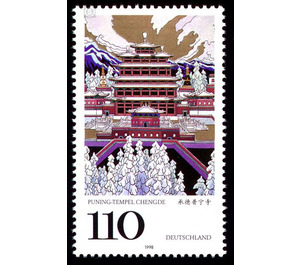Cultural and natural heritage of humanity - Germany / Federal Republic of Germany 1998 - 110 Pfennig
Theme: Architecture
| Country | Germany / Federal Republic of Germany |
| Issue Date | 1998 |
| Face Value | 110.00 |
| Perforation | K 13 3/4 |
| Printing Type | offset |
| Stamp Type | Postage stamp |
| Item Type | Stamp |
| Chronological Issue Number | 1881 |
| Chronological Chapter | GER-BRD |
| SID | 432545 |
| In 35 Wishlists | |
The buildings honored in the joint postage stamp issue are more than just a UNESCO World Heritage Site. Both complexes were built in the 18th century and used by both secular and spiritual rulers as a residence and official residence. The former residence of the Würzburg prince bishops was built in the shell in the years 1720 to 1744, the interior was completed by 1780. It is one of the most important baroque palaces. Inside, it unites two major works of European architecture and painting - the staircase by Balthasar Neumann, a masterpiece of interior design and vaulting technique, and the magnificent ceiling fresco by Venetian Giovanni Battista Tiepolo. The Puning Temple is one of the Eight Outer Temples of the old summer residence in Chengde, China, about 250 kilometers northeast of Beijing. The entire complex is one of the most exquisite examples of court culture in China in the 18th century. The palace building lasted from 1703 to 1790. Outside the enclosure wall, the Eight Outer Temples symbolize the different ethnic groups of China. The Puning Temple was built in 1755 to commemorate a victory over the insurgent Dzungar, a Mongol nomadic tribe. The Würzburg Residence has been on the UNESCO World Heritage List since 1994, the imperial summer residence in Chengde since 1994.


